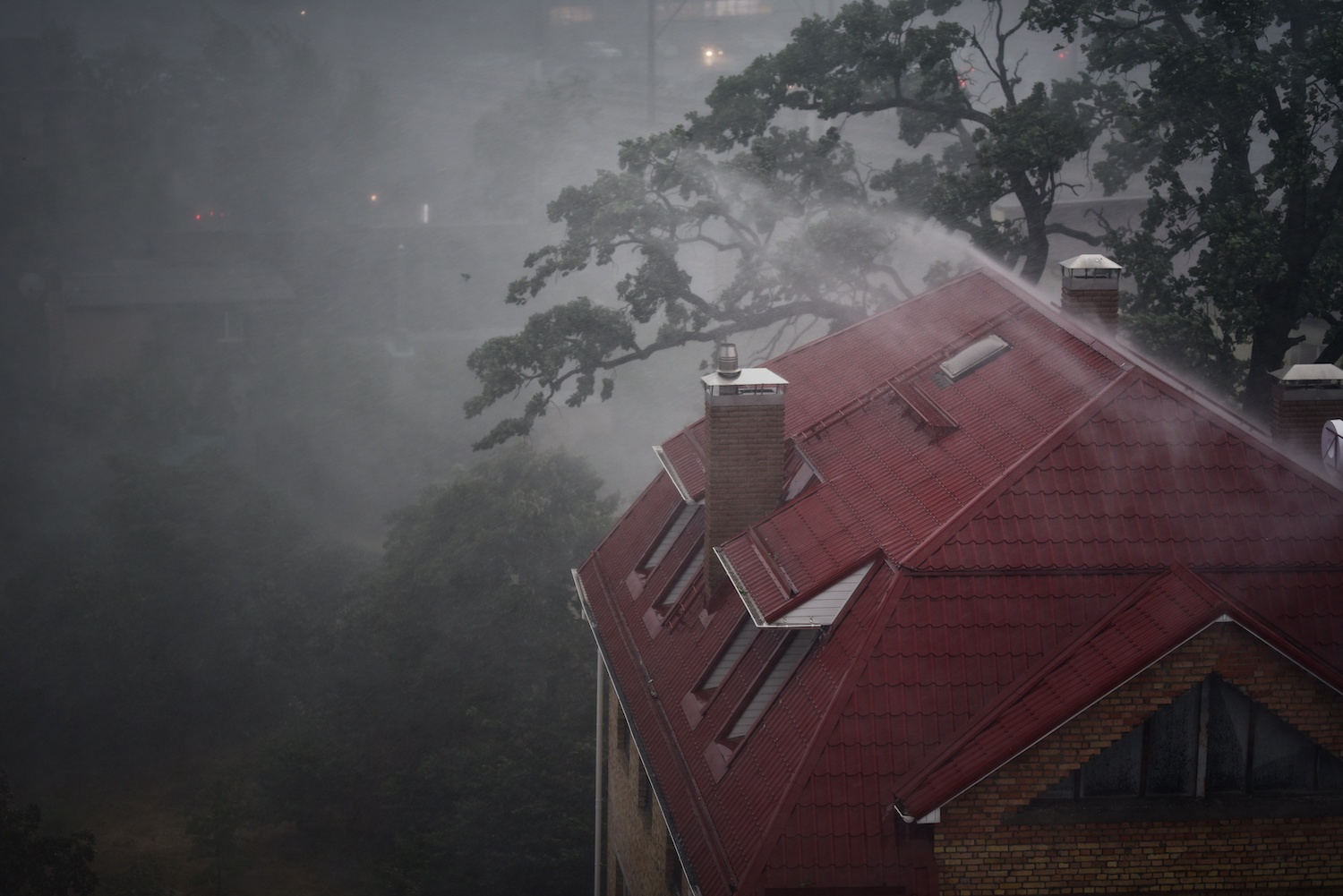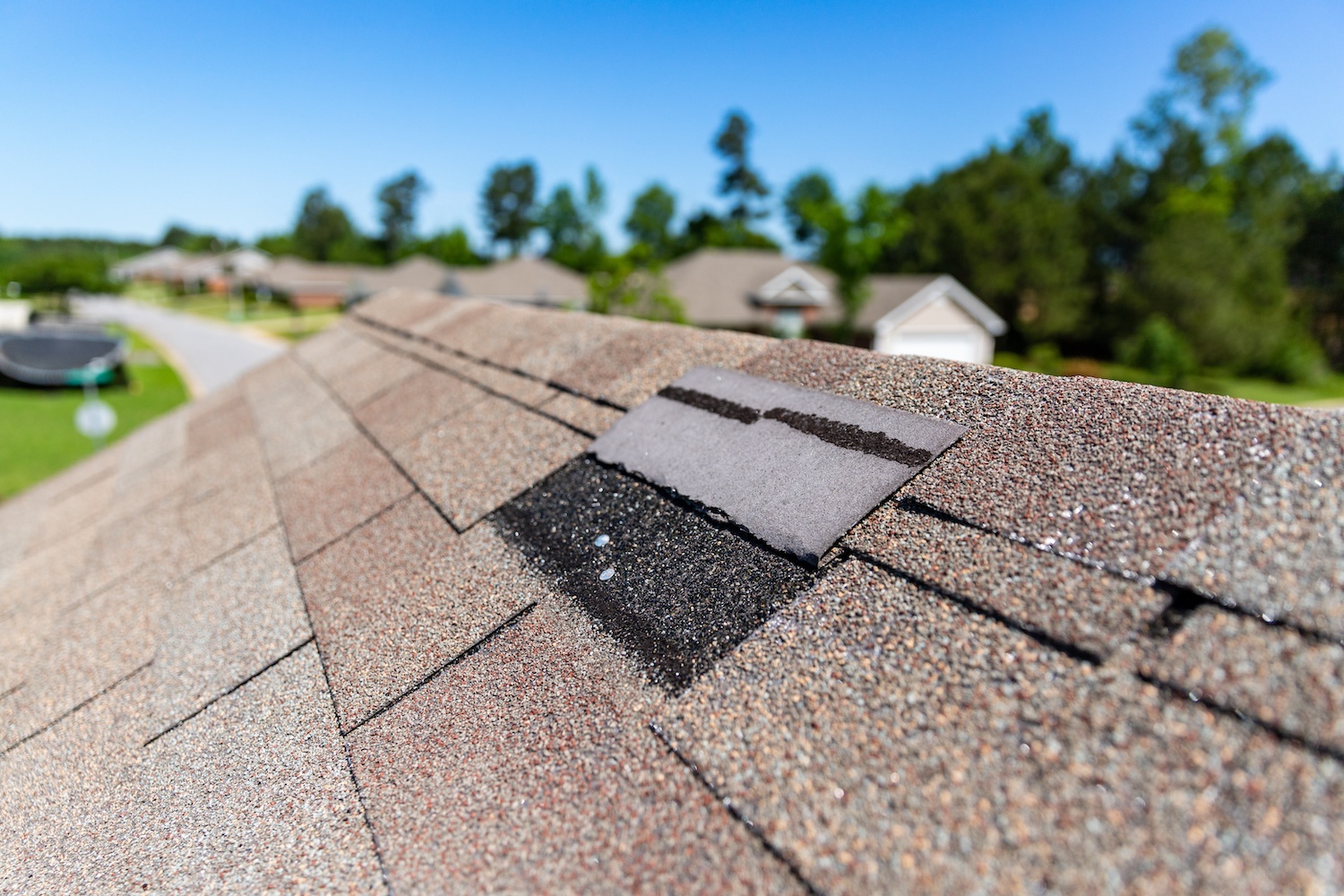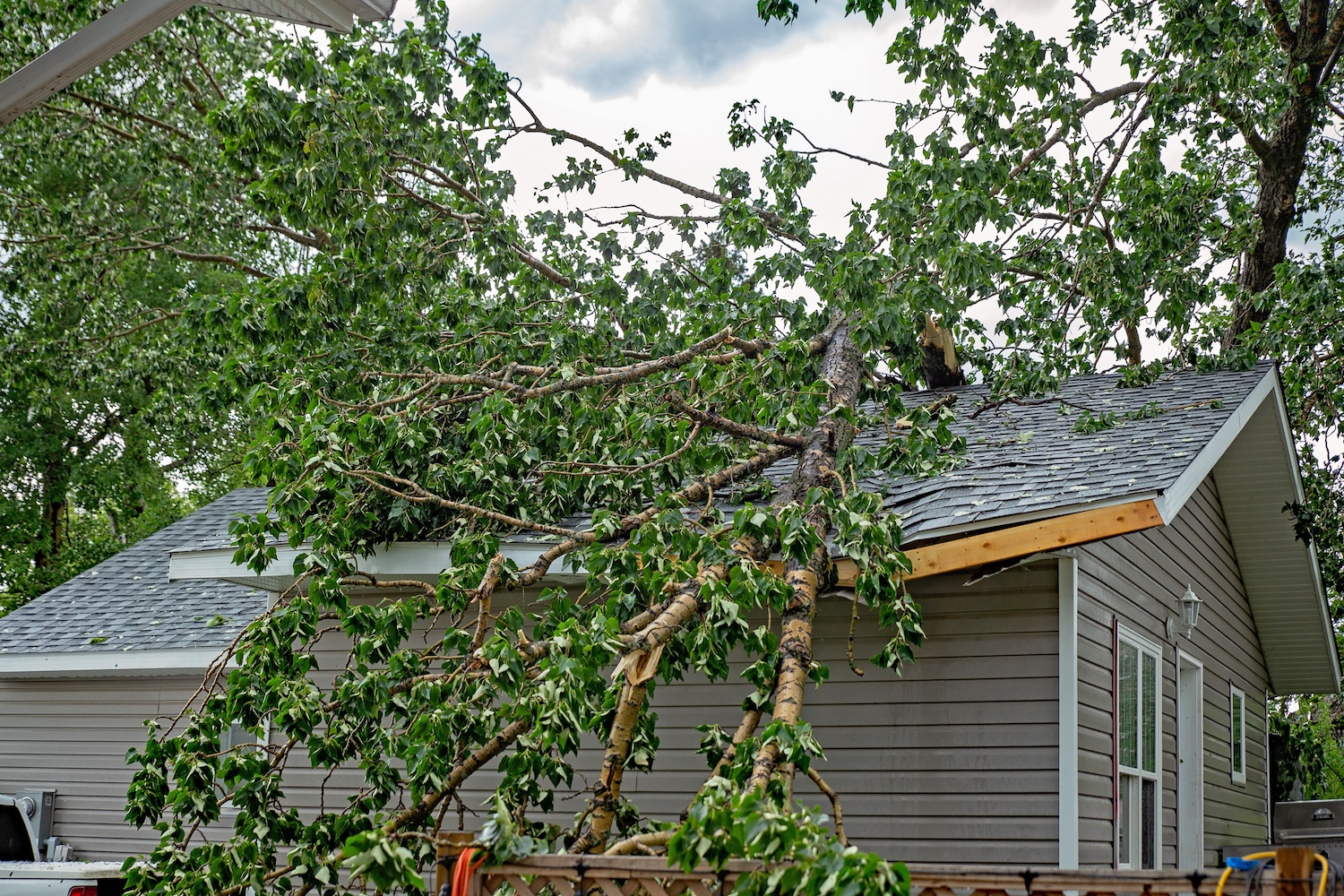
How to Tell if Your Roof Was Damaged by High Winds


If you’re like most people, you probably don’t know how to tell if your roof has been damaged by high winds, or when you’ll need your roof replaced as a result. It’s not always easy to see the damage from the ground, and sometimes it can be difficult to determine whether or not the wind was actually responsible. Some minor signs that you has experienced roof wind damage include:
- Lifted up shingles
- Missing shingles
- Large debris on your roof
This guide will discuss some of the most common ways to spot wind damage on your roof so that you can schedule the necessary roof repairs.
We will also provide some pictures of what wind damage can look like. Hopefully, this information will help you make a quick decision to call your local roofer and get it fixed ASAP.

What Is Roof Wind Damage?
Roof wind damage is caused by strong winds that can lift and blow shingles, tiles, or other roofing materials off of your home. This type of damage is most common in areas that are prone to severe weather conditions such as hurricanes, tornadoes, and severe thunderstorms.
In some cases, the wind can be so strong that it can actually cause the entire roof to lift up. This is why it’s so important to be aware of the signs of wind damage and to have your roof inspected by a professional if you suspect that it may have been damaged.
While the wind itself is why you’re experiencing damage in the first place, it’s commonly the hail or debris that is thrown against your home during a wind storm that causes the most damage. So even if you experience severe winds, it’s vital to know other signs to look for such as large branches or twigs on your roof which could also indicate damage.
How to Spot Wind Damage on Your Roof
As we mentioned before, wind damage is not always easy to spot. Sometimes, the damage can be minor and only visible from close-up. Other times, the damage can be more severe and easily visible from the ground. Some signs of wind damage include:
Lifted or Curling Shingles
When individual shingles on your roof appear upturned, lifted, or curled, there’s a problem. You might notice these because they seem out of line or out of place when you glance at your roof. Instead of nice straight rows of shingles, these ones might be askew or overlapping other shingles.
Flipped or Bent Shingles
If you see your shingles flapping in the wind or on a calm day, it’s an indication your roof should be checked for damage. A strong enough wind can easily blow under your shingles in the tiniest spot and be strong enough to bend them back or rip the nails out so the entire section lifts up. This immediately makes your home susceptible to leaks and must be remedied right away.

Interior Water Leakage
If you notice water stains on your ceilings in the house, this often indicates an immediate leak caused by roof wind damage. To remedy this quickly, it’s important to either tarp the roof if it is safe to do so or place a bucket underneath the roof leak while you wait for a roofer to inspect and repair the area. Water leaks can cause mold growth if left unattended.
Missing Shingles
If the shingles have vanished, it’s a very obvious indication that your shingles have been blown off by the wind. You should be able to easily spot missing shingles even from the ground looking up at the roof.
If you suspect that your roof has been damaged by wind, it’s important to have it inspected by a professional as soon as possible. They will be able to assess the damage and quickly determine a plan of action to get your roof repaired right away.
How to Inspect Your Roof for Wind Damage
While we always recommend hiring a professional roofer to inspect the damage on your roof, it is still your responsibility as a homeowner to maintain your property, and checking for damage after a storm is a part of that. So there are a few key areas you can check to determine whether or not you need to call in the pros.
After a strong wind storm or other severe weather, you should take a walk around your property to look out for any obvious signs of damage. But only when it’s safe. Here are a few places to look:
- Your gutters and downspouts
- The chimney flashing or window flashing
- Your attic or upper floor
- Look for large debris or furniture askew on the property
- Look at the neighbor’s houses
These can all indicate signs that you’ve experienced wind damage. If your gutters are crooked or dented, the flashing around your chimney is dented, or if you notice damage to neighbor’s homes— these are all good signs that wind was strong enough to cause widespread damage.
Steps to Take if You Suspect Wind Damage
If you suspect wind damage to your roof, there are three vital steps to take next.
1) Contact a Professional Roofer
This is always the best and most recommended option. A professional roofer will be able to quickly assess the damage, give you an estimate for repair, and help you file an insurance claim if necessary.
If you have a home warranty, this might also be a good time to contact them as well. Many home warranties cover roofs and can help you get the repairs you need without having to pay out of pocket.
Just remember, when meeting with a roofer, always ask for references and proof of insurance. This will give you peace of mind that they’re a reputable company that can be trusted to do a good job.
2) Document the Damage You Found
As you walk around your property, document anything you find. Note any dents, debris, or leaks. And take pictures! Taking photos and keeping a record of what your property looked like immediately after the storm can only help your case and ensure you don’t get a bad inspection or estimate from the roofer or insurance adjuster.
3) File a Claim With Insurance
If the damage is bad enough and you have homeowners insurance, your next step should be to file a claim. The insurance company will send out an adjuster to assess the damage and determine how much they’re willing to cover.
This is where that documentation comes in handy! If you have photos of the damage and a list of repairs needed, the adjuster will have a much easier time determining the cost of repairs.
Just remember, insurance companies might try to lowball you on the repair estimate. This is why it’s so important to document everything and have a professional roofer inspect the damage as well.
4) Schedule Your Roof Repairs
Once you’ve figured out how you’re going to pay for the repairs, it’s time to schedule them. If your damage is bad enough, you might need a temporary tarp placed on your roof until the repairs can be made.
But in most cases, roofers will be able to come out and make the necessary repairs relatively quickly and you’ll be back to normal with a roof that protects!
How Strong Does Wind Have to Be to Damage Your Roof?
Roof damage can occur even when the wind is blowing at only 30mph. But the type of damage and severity will differ depending on the wind speed. For example, if you have old or damaged shingles, they are more likely to fly off your roof in high winds.
In general, most roofs are designed to withstand wind speeds up to 110mph. But if you live in an area that experiences hurricanes or other severe weather regularly, your roof might be built to withstand even higher wind speeds. This chart gives a few good examples of the speed of wind vs. what damage can occur:
- 20-30 mph: Large branches sway and move
- 30-40 mph: Entire trees begin to sway and move
- 40-45 mph: Twigs and branches might break off of trees and fall to the ground (or on your roof)
- 45-55 mph: Weak limbs and large branches break off and can cause structural damage
- 55-65+ mph: Moderate to heavy tree or structural damage occurs
- 70+ mph: Heavy to severe tree and structural damage occurs
Tips for Protecting Against Wind Damage
While you can’t control the weather, there are a few things you can do to help protect your home against wind damage:
- Keep trees well-trimmed and away from your house. This will help prevent branches from falling on your roof in high winds.
- Secure outdoor furniture and other loose items. If you have any lawn chairs, grills, or other outdoor items, make sure they’re securely fastened so they don’t blow away and damage your property. Install hurricane shutters or impact-resistant windows.
- If you live in an area that experiences hurricanes or severe weather regularly, invest in some hurricane shutters or impact-resistant windows. These can help protect your home from debris and wind damage.
- Reinforce your garage doors. If your garage doors are old or damaged, they might not be able to withstand high winds. You can reinforce them by adding additional bracing or installing a wind-resistant garage door.
- Check your roof regularly. Inspecting your roof for damage and making repairs as needed can help uphold its integrity and keep it in tip-top shape to protect.
- Invest in wind-resistant shingles such as those that have been tested to withstand high winds. These shingles can help protect your roof against wind damage, even if a severe storm does come through.
How to Protect Your Roof from Hurricanes
Living in a hurricane-prone area means taking extra precautions to safeguard your home, especially your roof, against these powerful storms. Here are some strategies to ensure your stay safe from hurricane roof damage.
- Install Hurricane Straps: Hurricane straps or clips can significantly reinforce your roof’s structure by tying it more securely to the walls of your home. This extra reinforcement reduces the chance of your roof lifting off during strong winds.
- Use Hurricane-Resistant Shingles: When repairing or replacing your roof, opt for shingles that are rated for hurricane resistance. These shingles are designed to withstand high winds and can provide an added layer of protection.
- Apply Roofing Cement: Use roofing cement to seal the edges of shingles. This helps to prevent wind from getting under the shingles and lifting them off.
- Inspect and Maintain Regularly: Regular inspections are crucial for identifying and fixing potential weak spots that could be exacerbated during a hurricane. Check for and replace any loose or damaged shingles, and repair any small leaks promptly.
- Reinforce Your Roof Deck: Ensure that the roof deck is properly secured to the rafters or trusses. You can add more nails or use adhesive caulking to provide additional strength.
- Clear Debris: Keep your roof and gutters clear of leaves, branches, and other debris, which can become missiles during high winds. Also, trim nearby trees to prevent branches from breaking and damaging the roof.
- Install a Secondary Water Barrier: A secondary water barrier provides an additional layer of protection by preventing water from seeping through if the primary roof covering is damaged. This can be especially useful during the torrential rains that accompany hurricanes.
- Secure Roof Vents and Skylights: Ensure that all roof vents, skylights, and other openings are securely sealed and reinforced to protect against water intrusion and wind damage.
- Consider a Metal Roof: Metal roofs are known for their durability and are often better suited to withstand the powerful winds of a hurricane compared to traditional asphalt shingles.
Taking these measures can drastically reduce the risk of severe roof damage during a hurricane, protecting not only the roof itself but also the entire structure of your home. Always consult with a professional roofing contractor to ensure that your hurricane protection measures are properly installed and maintained.

Will Insurance Cover the Costs?
Hurricane roof damage claims can save you time and money. Your insurance policy can vary based on the type of policy you have and its specific terms:
- Homeowners Insurance: Generally, most standard homeowners insurance policies include coverage for wind damage. However, the level of coverage can differ from one policy to another. It’s crucial to thoroughly review your policy to understand what is and isn’t covered.
- Deductibles: Keep in mind that your insurance policy will have a deductible—the amount you must pay out-of-pocket before your insurance begins to cover the rest. Make sure you know your deductible amount and plan accordingly.
- Exclusions and Conditions: Policies may include exclusions or special conditions regarding wind damage. For example, some policies might not cover damage caused by hurricanes or tornadoes, or require specific preventative measures to be in place. Carefully read your policy to identify any such exclusions or conditions.
- The Claims Process: To ensure a smooth and successful insurance claim, proper documentation and timely reporting are essential. Take detailed photos of the damage, keep receipts for any emergency repairs or accommodations, and follow your insurer’s guidelines meticulously. Promptly reporting the damage and staying in communication with your insurance provider can significantly impact the outcome of your claim.
Understanding these factors will help you navigate the complexities of insurance coverage for wind damage and ensure you are adequately prepared should the need arise.
After a Wind Storm, Work With a Reputable Roofing Contractor
If you do experience wind damage to your roof, it’s important to work with a reputable roofing contractor to make the necessary repairs. A professional roofer like Monarch Roofing will be able to assess the damage and make sure all of the repairs are made correctly so your roof can protect your home for years to come.
If you’re not sure where to turn first, contact Monarch Roofing and we can discuss your options for inspections and repair and get you back to your daily life with little interruption.